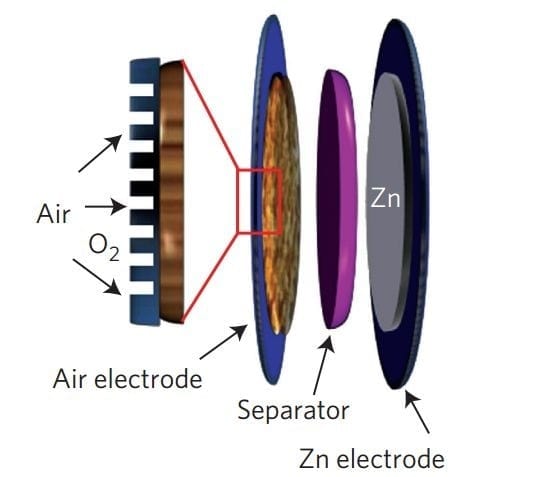RESEARCHERS NOW OPTIMIZING CHEAP, EASY-TO-MAKE ALTERNATIVE
Researchers from South Korea, Case Western Reserve University and University of North Texas have discovered an inexpensive and easily produced catalyst that performs better than platinum in oxygen-reduction reactions.
The finding, detailed in Nature’s Scientific Reports online today, is a step toward eliminating what industry regards as the largest obstacle to large-scale commercialization of fuel cell technology.
Fuel cells can be more efficient than internal combustion engines, silent, and at least one type produces zero greenhouse emissions at the tail pipe. Car and bus manufacturers as well as makers of residential and small-business-sized generators have been testing and developing different forms of fuel cells for more than a decade but the high cost and insufficiencies of platinum catalysts have been the Achilles heel.
“We made metal-free catalysts using an affordable and scalable process,” said Liming Dai, the Kent Hale Smith Professor of macromolecular science and engineering at Case Western Reserve and one of the report’s authors. “The catalysts are more stable than platinum catalysts and tolerate carbon monoxide poisoning and methanol crossover.”
And, in their initial tests, a cathode coated with one form of catalyst—graphene nanoparticles edged with iodine—proved more efficient in the oxygen reduction reaction, generating 33 percent more current than a commercial cathode coated with platinum generated.
The research was led by Jong-Beom Baek, director of the Interdisciplinary School of Green Energy/Low-Dimensional Carbon Materials Center at South Korea’s Ulsan National Institute of Science and Technology. Fellow authors include: In-Yup Jeon, Hyun-Jung Choi, Min Choi, Jeong-Min Seo, Sun-Min Jung, Min-Jung Kim and Neojung Park, from Ulsan; Sheng Zhang from Case Western Reserve; and Lipeng Zhang and Zhenhai Xia from North Texas.
Like a battery, a fuel cell converts chemical energy into electrical energy. It works by removing an electron from a fuel, usually hydrogen or methanol mixed with water, at the cell’s anode, or positive electrode, creating a current.
Hydrogen ions produced then pass through a membrane to the cathode, or negative electrode. Here, oxygen molecules from the air are split and reduced by the addition of electrons and combined with the hydrogen ions to form water and heat—the only byproducts.
A better, cheaper catalyst than scarce and costly platinum is required if hydrogen fuel cells and direct methanol fuel cells are to become realistic alternatives to fossil fuels, the authors say.
The technology to make alternative catalysts builds on a simple and cheap industrial process several of the researchers developed to make graphene sheets from graphite.
Inside a ball miller, which is a canister filled with steel balls, the researchers broke graphite down into single-layer graphene nanoparticles. While the canister turned, they injected chlorine, bromine or iodine gas to produce different catalysts.
In each case, gas molecules replaced carbon atoms along the zigzag edges of nanoplatelets created by milling. Not only were the edges then favorable to binding with oxygen molecules, but the bond strength between the two oxygen atoms weakened. The weaker the oxygen bonds became, the more efficiently the oxygen was reduced and converted to water at the cathode.
In testing, a cathode coated with iodine-edged nanoplatelets performed best.
The Latest Bing News on:
Metal-free catalyst
- Oil Prices Climb as Bullish Catalysts Buildon April 26, 2024 at 6:45 am
Oil prices are set to post a weekly gain as bullish catalysts build while geopolitical risks remain very much present.
- Trash To Treasure: Researchers Turn Metal Waste Into Catalyst for Green Hydrogenon April 16, 2024 at 5:01 pm
Scientists have found a way to transform metal waste into a highly efficient catalyst to make hydrogen from water ... Our press release publishing policy can be accessed here. Subscribe for FREE ...
- Metal waste as catalyst for hydrogen (VIDEO)on April 16, 2024 at 12:00 pm
To view this video please enable JavaScript, and consider upgrading to a web browser that supports HTML5 video Disclaimer: AAAS and EurekAlert! are not responsible ...
- Trash to treasure -- researchers turn metal waste into catalyst for hydrogenon April 15, 2024 at 5:00 pm
Scientists have found a way to transform metal waste into a highly efficient catalyst to make hydrogen from water, a discovery that could make hydrogen production more sustainable. Scientists have ...
- Discovery of organic catalyst could lead to cheaper fuel cellson April 15, 2024 at 9:01 am
With atmospheric carbon dioxide at record highs, the search for clean-energy alternatives to the use of fossil fuels is growing increasingly urgent.
- Murata’s Groundbreaking Ceramic Catalyst Material Eliminates Precious Metal Reliance and Cuts Carbon Emissionson April 10, 2024 at 5:00 pm
Primarily, the initial system cost is far more predictable, free from the price fluctuations seen with precious metals. Furthermore, the performance of precious metal catalysts can become ...
- Murata's Groundbreaking Ceramic Catalyst Material Eliminates Precious Metal Reliance and Cuts Carbon Emissionson April 9, 2024 at 5:00 pm
Primarily, the initial system cost is far more predictable, free from the price fluctuations seen with precious metals. Furthermore, the performance of precious metal catalysts can become compromised ...
The Latest Google Headlines on:
Metal-free catalyst
[google_news title=”” keyword=”Metal-free catalyst” num_posts=”10″ blurb_length=”0″ show_thumb=”left”]
The Latest Bing News on:
Catalyst
- Nkarta: Down 50% Since March With A Clinical Catalyst Aheadon April 27, 2024 at 7:27 am
NKTX has already produced some data with NKX019 in oncology with more data coming mid-year. Read the article to learn more about the buy rating.
- Catalyst Watch: This Beaten-Down, High-Yield Dividend Stock Is Working on a Long-Term Solution to Its Biggest Issueon April 27, 2024 at 6:36 am
NextEra Energy Partners is working to address the looming buyouts of its remaining convertible equity portfolio financing.
- Kroeplin a catalyst as Delran softball earns a winon April 26, 2024 at 4:27 pm
Gianna Kroeplin had a pair of hits, stole two bases and drove in three runs to lead Delran to a 9-5 win over West Windsor-Plainsboro North in Delran. The Bears collected 12 hits off West Windsor ...
- BitMEX Founder Arthur Hayes Says One Catalyst Could Lead to a Re-Acceleration of the Crypto Marketon April 26, 2024 at 11:05 am
BitMEX co-founder Arthur Hayes believes one catalyst could re-ignite bullish momentum for the cryptocurrency market.
- Bitcoin Halving 2024: A Catalyst for Innovation, Adoption, and Market Stabilityon April 26, 2024 at 7:06 am
As the clock edged toward midnight on the eve of Bitcoin Halving 2024, the cryptocurrency community was immersed in anticipation.
- ‘Violent to the Upside’: This Catalyst Could See Bitcoin Explode by up to 1,486%, Says Strike CEO Jack Mallerson April 26, 2024 at 12:04 am
The CEO of Bitcoin’s Lightning Network wallet Strike Jack Mallers is predicting that the flagship crypto asset could reach a seven-figure price during the current cycle.
- Now hitting second, Elly De La Cruz continues to be a catalyst in a Reds winon April 25, 2024 at 9:22 am
Elly De La Cruz drove in a key run with a line drive double against a left-handed pitcher as the Reds beat the Phillies.
- The UK Market May Have Found Its Catalyston April 25, 2024 at 5:01 am
Welcome to Money Distilled. I’m John Stepek. Every week day I look at the biggest stories in markets and economics, and explain what it all means for your money. When this week’s Merryn Talks Money ...
- 'The catalyst that motivated us' | Texas EquuSearch shares message to parents of Kay-Alana Turner after possible remains foundon April 22, 2024 at 3:47 pm
According to court documents, Kay-Alana was parked in a woman's driveway and refused to leave. Deputies were called to the home and when they arrived, she allegedly drove off the driveway and crashed ...
- Penske launches Catalyst AI for fleet performance insightson April 18, 2024 at 6:36 am
Catalyst AI allows fleet managers to compare their own performance to that of similar fleets across Penske’s database.
The Latest Google Headlines on:
Catalyst
[google_news title=”” keyword=”catalyst ” num_posts=”10″ blurb_length=”0″ show_thumb=”left”]












